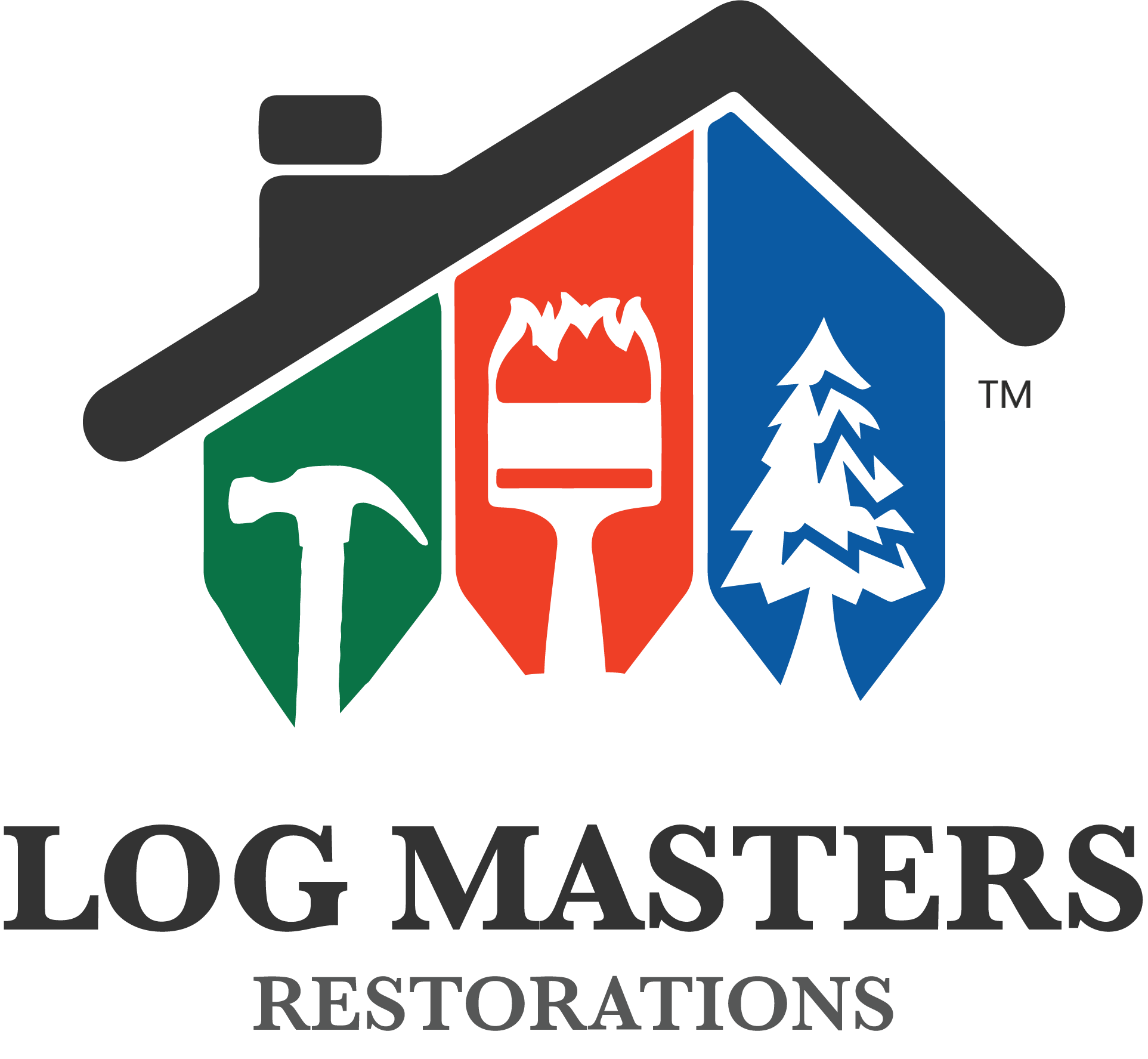Most experienced log homeowners have a basic understanding of what log home maintenance entails. However, many do not realize all of the factors that go into a log home restoration estimate. When we quote a restoration or maintenance job, we must not only walk through our log home maintenance checklist to determine what work is necessary but also consider travel and equipment requirements, the style of log home we are working on, and the home’s maintenance history.
If you have questions about all of the factors we consider in a log home estimate, you’re in luck because we have all the answers! By the time you read this post, you will also have this Log Master knowledge at your disposal.
Basic Information Needed to Start Your Restoration Estimate
When homeowners call our toll-free number, we will ask for the basic information most service providers need to begin a project. This includes:
- First and last name
- Phone number and email address
- The physical address of the cabin
- The square footage of your log home
- What prompted you to call?
It seems normal, but some prefer to keep out their phone number or physical location out of fear. Rest assured, we do not share information collected or sell our client list. We hate it when companies do it to us, so to avoid hypocrisy and show respect for our clients, we refuse to participate in selling our client list. Whatever you share stays in-house for in-house use only.
After we collect this basic information, we will ask you to send us photographs of your log home.
Log Home Photos: A Necessity for Online Estimates
They say a picture is worth a thousand words, and this could not be truer when providing a log home restoration estimate. These images give us an idea of the log home’s condition and help us determine the cabin’s floor plan, the land surrounding the home, and any obstacles we may need to work around.
In many cases, it’s easier for us (and for you) if we can see the log home. This is because it’s hard to verbalize certain types of damage or areas of concern.
List of Suggested Pictures
This list of suggested log home photographs ensures your log home’s needs are effectively communicated. Please keep in mind this list is not exhaustive, and we may request additional photos for more context.
To start, we suggest you take pictures of the following environmental obstacles:
- A house over a lake or water
- Road access problems
- Power lines that are attached to the log cabin
- Your windows and door frames (common areas for log rot or insect damage)
- Facia and nearby logs
- Logs near the ground (especially if the log height is less than one foot above the ground)
- Areas of regular shade (you will often see a green hue on these logs)
- West and south-facing walls (they get the most rain)
- East and north-facing walls (especially if your location makes it difficult for them to dry out)
- Decks (if you want it included in your estimate)
- Posts or columns on the front or back porches
- Any cracks, bubbling, or weathered chinking and finishing
- Extended horizontal checks (cracks) in the logs that may hold rain (typically on the top of a log)
- Signs of insects
- Other areas that would benefit from an expert eye
Guidelines for Precise Pictures
You can use a phone or camera to photograph the items mentioned above. The device does not matter; it’s the precision we care about in order to make an accurate repair or restoration estimate. This avoids inaccurate estimates or change orders once we arrive and begin the work.
For areas of concern that include cracks, log rot, or other blemishes, we recommend using a ruler, tape measure, quarter, or soda to provide perspective within the images. Also, it helps if you can take multiple shots from different angles of potential log rot, insect damage, caulk or chink separation, and cracked or missing finishes.
If you need clarification, please call us so we can assist you.
Primary Factors Impacting Your Restoration Estimate
One of the best things about log homes is most of them are unique. However, this means that we can’t provide cookie-cutter restoration estimates. We must evaluate each home with fresh eyes and assess what is needed.
With your photos, we can accurately assess your log home’s needs. We may recommend the products and services listed below based on what we see. We love sharing our expertise to educate our clients on how the types of logs, caulk or chink, log rot or insect damage, and issues with clear finishes impact our log home repair estimate.
1. Type of Log Home Exterior
What makes a log home a log home? The exterior and interior? Is it based on appearance or structural makeup? Depending upon who you ask, opinions on what qualifies as a log home vary. Big or small, there are two types of cabins: log-sided and log-built.
Log Sided Homes
Log-sided homes can look just as beautiful as a log cabin. This “log home look” is budget-conscious but requires regular maintenance, just like any other log home. We can replace pieces with log-sided homes if they are rotted without impacting the structural integrity. However, we must also take certain precautions to avoid damage to interior walls.
Additionally, log-sided homes are still log homes, meaning they must be regularly stained. Stain protects the wood from water and other elements while preserving its natural beauty.
We may ask additional questions about the type of log siding used on your home to provide the most accurate restoration estimate.
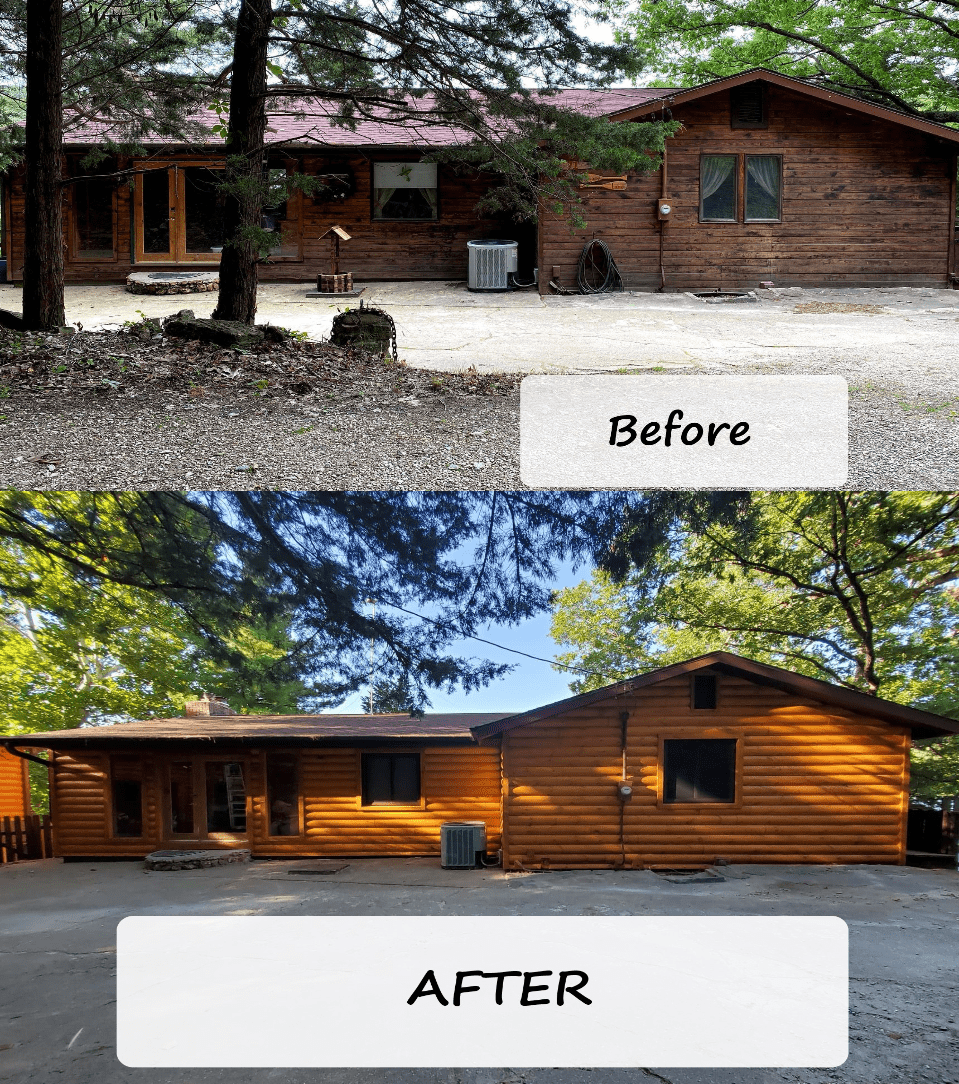
Log-Built Homes
There are a variety of styles for log-built homes, both in terms of log style and log species. These homes can be made from a variety of trees, including fir, cedar, pine, oak, and cypress. Furthermore, log homes can be built in different ways, such as full scribe, post and beam, timber frame, and more. These decisions are often made based on personal preferences and functionality, but they are also variables that can impact the cost of log home restorations and repairs.
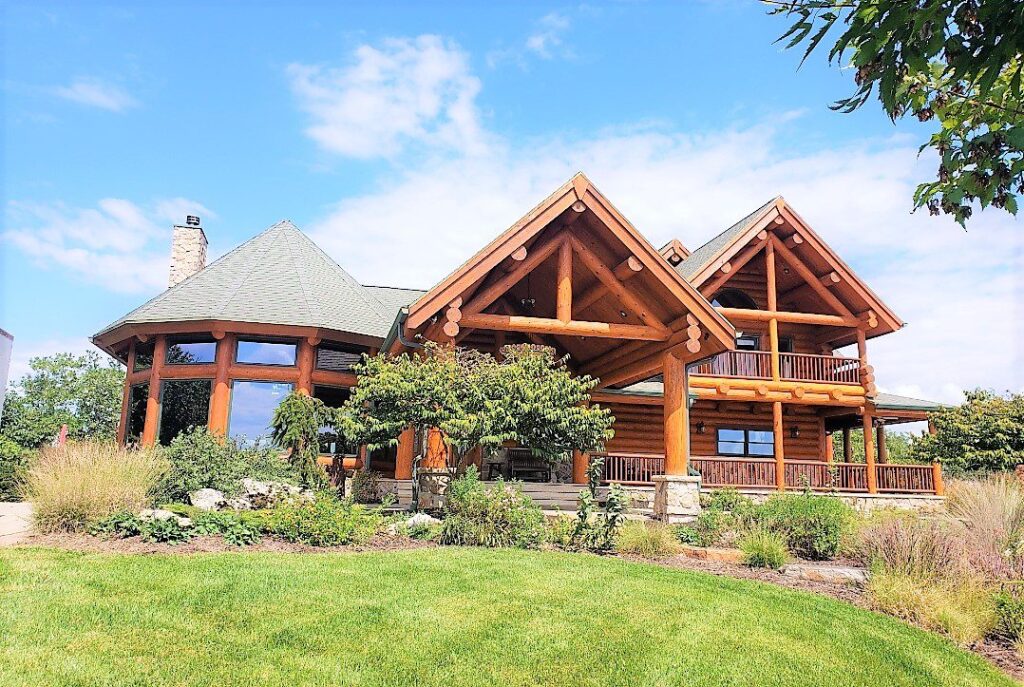
2. Log Styles
It’s also important for us to know the type (or types) of log style used to construct your cabin. Knowing your type of log style is generally easy to tell from pictures. However, your home may have multiple kinds of logs or styles of logs and log siding or a combination. It is not unheard of to discover part of the cabin was made with Douglas fir logs in a specific style and an addition to the home done in cedar logs of a different style and log siding around the foundation.
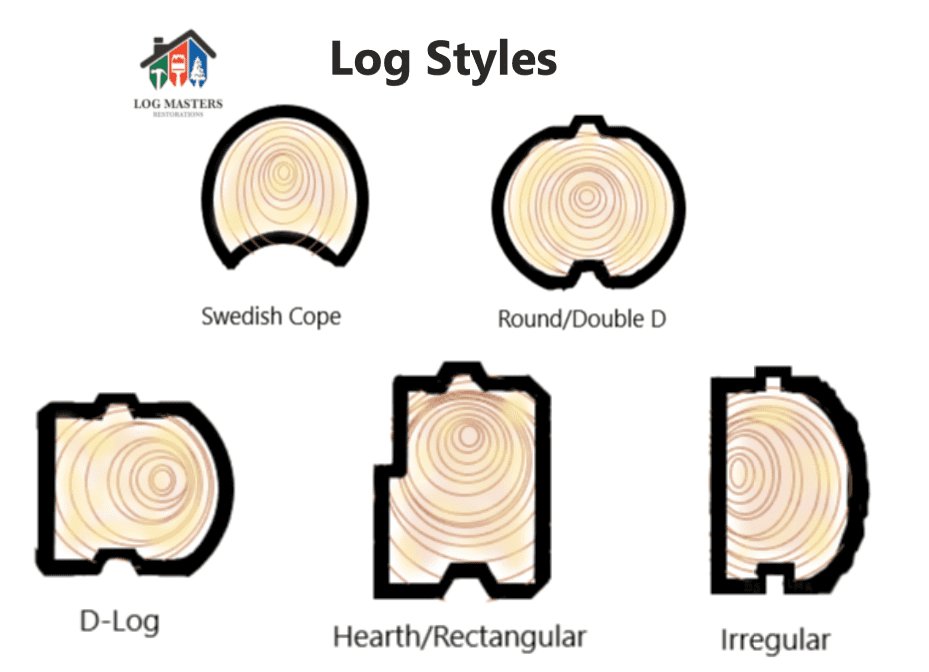
Log styles can go a step further when considering the exterior log surface, joints, corners, and ends. Each of these also contributes to factors drastically impacting the time needed to fix log rot in a given area. Some log rot is only a foot or two in length. To save money, rather than order a complete log in that style, a skilled log master may cut/mill another log on the site.
3. Chink and Caulk
Log homes typically use caulk or chink between the logs as a barrier from the elements and to protect the logs from water damage. The main difference between the two is elasticity and texture. Chink is more commonly used for large gaps between logs and is sometimes two inches wide, while caulk is used for smaller or tight gaps.
Mortar vs. Synthetic Chink
Two types of chinking are typically used in log homes: mortar and synthetic. Each has its pros and cons, and both can impact your log home repair estimate.
Mortar chinking is a concrete-like substance that is generally cheaper and around 10% of the price of synthetic chinking. However, mortar can crack and break down as the house settles, allowing moisture between the logs. Also, mortar chinking can be more challenging to remove, especially if trapped moisture causes log rot.
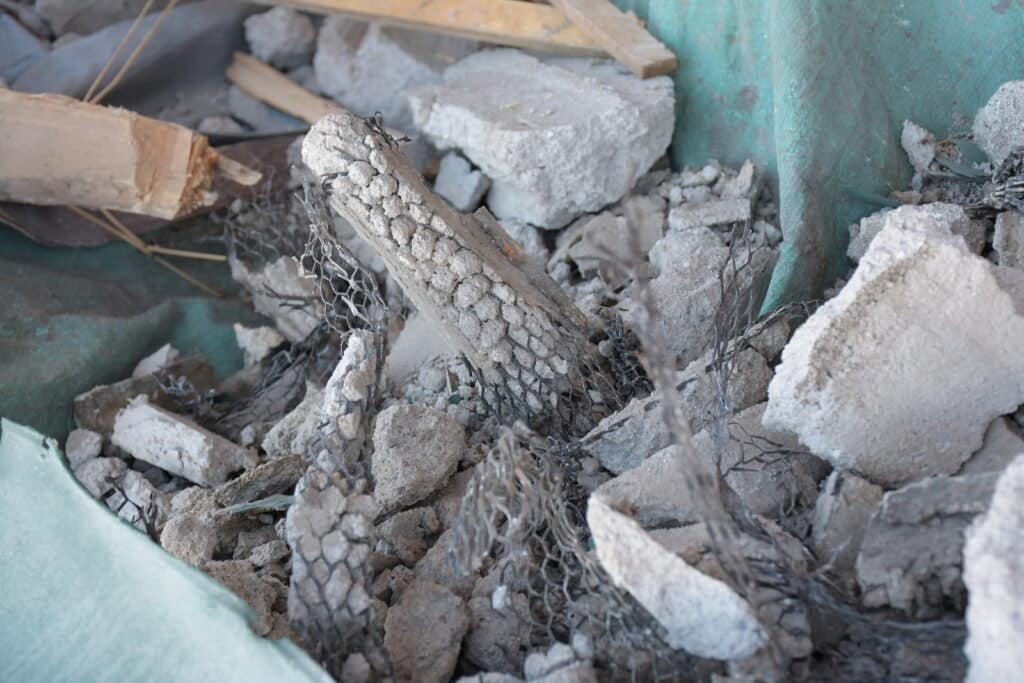
Nowadays, chink is made from synthetic material to allow for more elasticity to combat the seasons when the logs shrink and expand. Although the initial cost can be more expensive, it is far more durable and likely to prevent costly repairs in the future.
Caulking
Caulk is almost always used around windows and doors or small tight joints on log homes. It has a higher elasticity than chink but often lacks textures. Likewise, it comes in a few colors to match the stain, chink, making it nearly invisible to the naked eye. It is also much easier to apply than chinking, meaning less time spent restoring your home. Less time often equals lower costs.
4. Log Rot and Insects
Customers often call us for restoration estimates because they have noticed areas of concern on the exterior of their homes. Both log rot and insect infestation can cause extreme damage and represent the bulk of the estimated costs.
Log rot is at the top of most log cabin homeowners’ concerns. You may have noticed black behind the finish or chunky pieces falling away. These could be signs of log rot or a poor finish. Often, log rot occurs due to the homeowner’s inability to keep up with regular maintenance or their inability to heed the recommended care instructions of the log home builder. Unfortunately, since most types of log rot require us to replace the affected logs, it is a major consideration for log home restoration estimates.
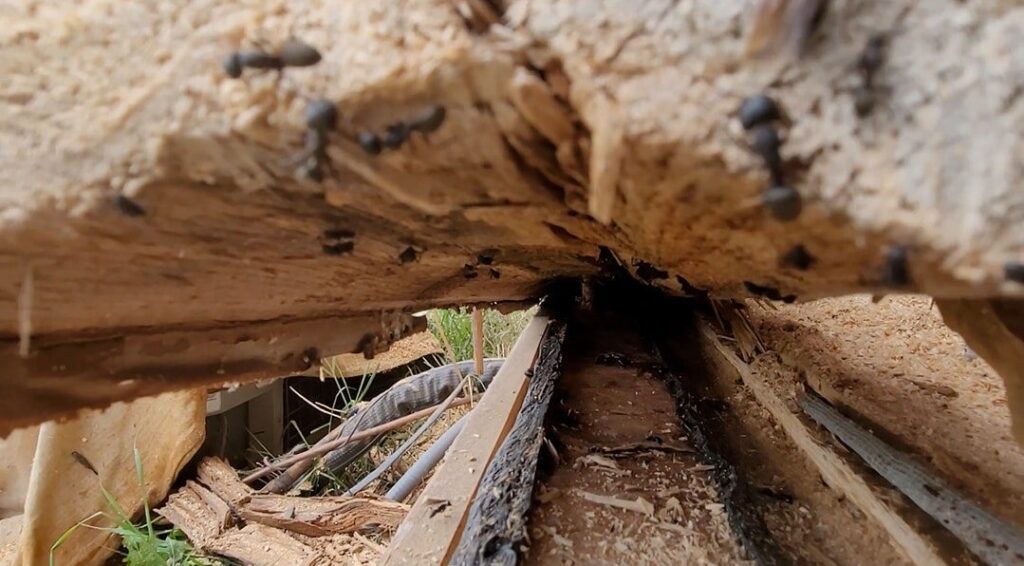
Insect damage comes in as a close second for homeowner concerns, as most types of insect infestations are highly visible. Although insect damage doesn’t always require us to completely replace logs, it does involve a series of removal and repair steps before we can re-stain the logs.
5. Damage From Previous Restoration Projects
Given current prices for home construction materials, we know it is tempting to hire a friend or self-employed individual with construction experience to repair your log home. Construction or carpentry experience is a background we look for when hiring Log Master’s Apprentices, but it is not the only experience needed to restore log cabins. Carpentry is a great skill set with a lot of value. Any good carpenter could probably learn how to restore a log cabin with time and education.
However, restorations not done by a professional can cost you, especially if the person makes one (or several) log home restoration mistakes.
Our apprentices, journeymen, and masters have seen multiple cabins with various issues and repairs. Our trained employees know what products and tools to use and how to use them most efficiently and effectively. They know how to recognize details and issues that can be overlooked. Also, they know what not to do, which is very important when working on your dwelling.
Bad Restoration Example
We have had customers call us after having someone else “restore” their log home. Although the original contractor was cheap, many customers eventually realize that when you hire the cheapest option, you get what you pay for… and then some.
The “and then some” is typically the damage caused and how bad it looks when the “cheaper guy” is done. Sometimes, it means more time and additional repairs since the original work was ineffective. If you don’t want to spend twice the amount to repair your log home, don’t call just any guy.
![They even tried to fill in the log-rotted spots with unmatched caulking, ensuring further log rot.[/caption]](https://logmastersrestorations.com/wp-content/uploads/2024/01/Screenshot-2024-01-17-103028-1-1024x609.png)
They even tried to fill in the log-rotted spots with unmatched caulking, ensuring further log rot.
For example, one of our customers paid for a local guy to restore his cabin. When we got to the cabin, you could instantly see why the customer had called us. The right products were used, but the application was unsightly. Products were applied incorrectly, and attempts to mask this made the situation even worse.
Log rot had been covered up by a thick coat of stain and finish and had spread to several neighboring logs. This meant he had wasted his budget and was now going to have to spend more money to counteract the damage.
6. Issues With Clear Finishes
Choosing a clear finish without stain may showcase the natural beauty of your logs, but it can create challenges when it comes to restoration. Clear finishes lack the UV protection and durability provided by pigmented stains, making your log home more susceptible to sun damage, moisture issues, and other wear and tear.
When assessing your home for restoration, we often see the following issues with clear finishes:
- Cloudy or uneven appearance
- Black spots or patches, indicating moisture damage
- Cracks, peeling, or bubbles, often caused by improper application or aging
These issues can increase restoration costs due to the need for additional surface preparation, repair, and refinishing. Regular maintenance and choosing a stain with UV protection can help avoid these problems and keep your log home in optimal condition.
7. Lack of Regular Maintenance
Neglecting regular maintenance is one of the most significant factors that can increase the cost of log home restoration. Over time, issues like log rot, moisture damage, and finish deterioration become more severe without proper upkeep, leading to extensive repairs.
When maintenance is delayed or skipped, restoration estimates often rise due to:
- Increased surface preparation, such as sanding or stripping deteriorated finishes.
- More extensive repairs, including replacing logs damaged by rot or moisture.
- Higher material costs, as neglected finishes wear out faster and require more frequent reapplication.
Regular maintenance—typically every 2–3 years in humid climates and 4–5 years in arid areas—helps protect your home and minimize restoration costs. Skipping this upkeep only accelerates damage, making restoration projects more labor-intensive and expensive.
Other Considerations for Log Home Restoration Estimates
Although the primary factors influencing any log home repair estimate involve the logs, we must also consider additional costs and requirements when providing a quote.
1. The Location of Your Log Home
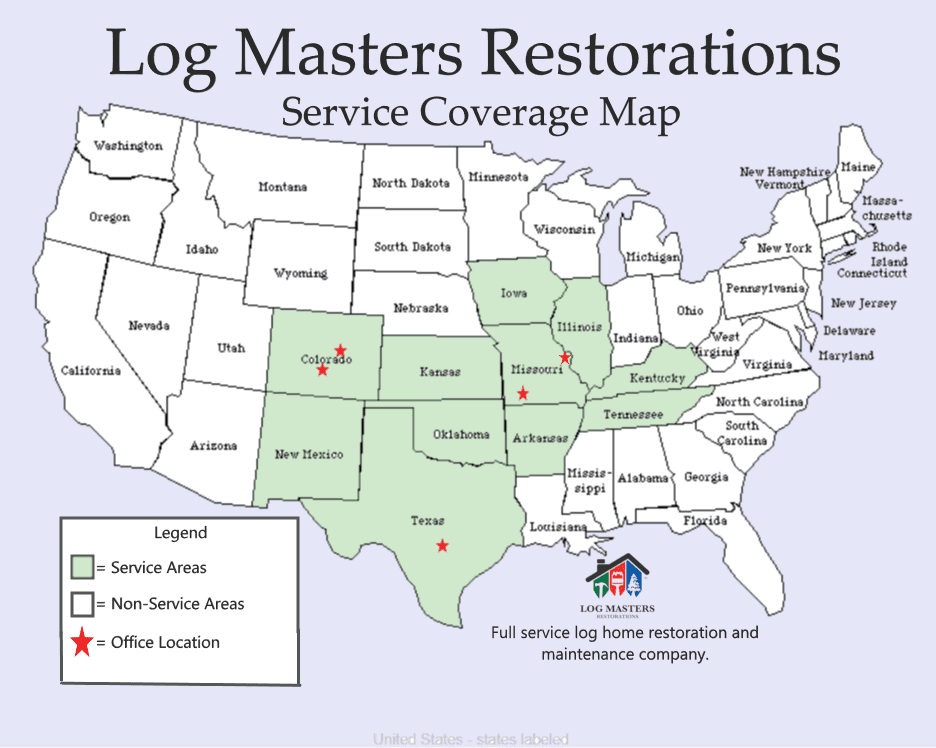
Knowing the location of your log home is a critical component of our restoration estimates. When you provide us with your address, we first look at your log home’s proximity to one of our five office locations. While we proudly serve log homeowners in Missouri, Arkansas, Oklahoma, Tennessee, Kentucky, Illinois, Iowa, Kansas, Texas, Colorado, Arizona, and New Mexico, we do factor the travel time and fuel costs into our estimate.
Furthermore, this knowledge helps us determine when (and if) we can come on-site to your log home. For example, if you live in a state neighboring one of our locations, like Nebraska, Mississippi, Wisconsin, or Indiana, it may or may not be feasible to travel to you, depending on where in the state you are located. In these cases, we don’t want to waste your time by requesting photos and other information to provide a service estimate.
2. Your Property and Landscape
Many timber house owners live in the countryside, nestled in a forest of trees and seclusion. With your address, we can access an aerial view of your property using Google Maps. This helps us determine the square footage of your log cabin and see if there are any obstacles near your log home or along the road where we will enter your property.
For instance, say your log home is high in the mountains, and the only way to it is up a winding dirt road that hugs the mountainside. This could impact our ability to transport heavy equipment. Similarly, if your log home is beside or over a body of water, we will consider this when recommending products for your project.
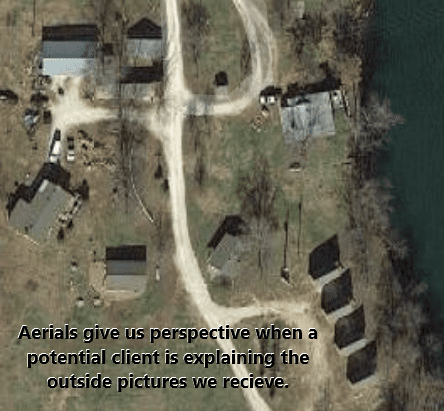
Additionally, we use your address to see a street view of your log home. This can tell us what challenges we may need to consider regarding scaffolding and ladders. While not all log homes have a street view online, some can be found on other websites like Zillow if the log home was sold at some point.
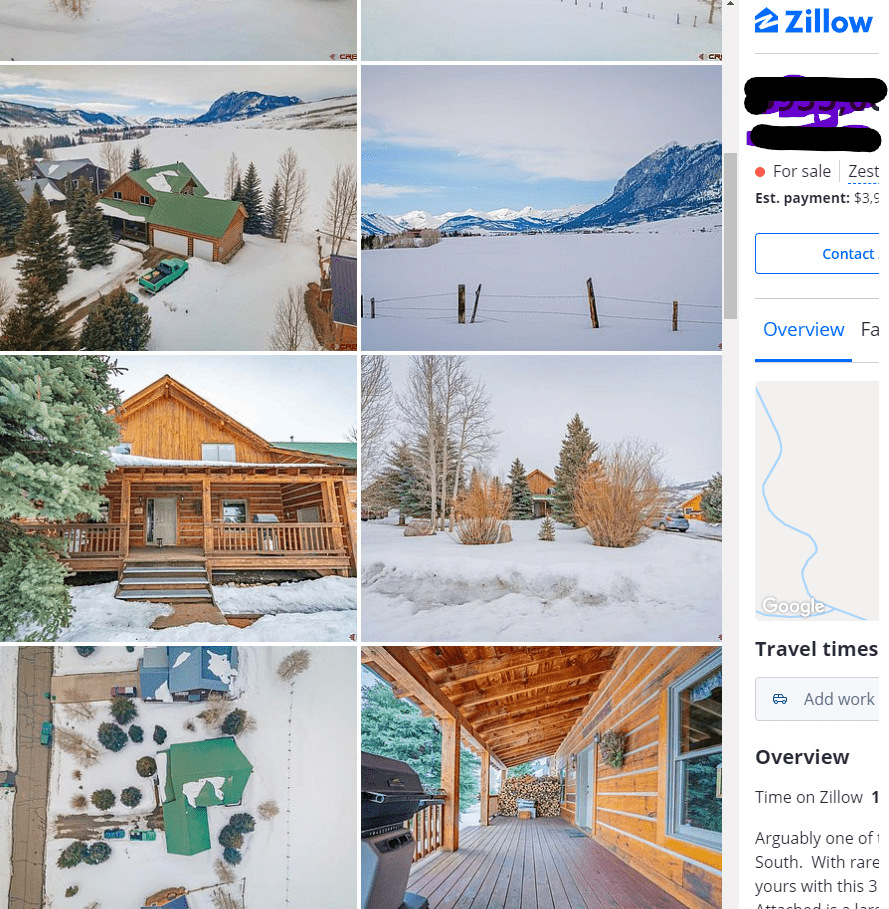
3. Travel Expenses
Since log home restoration requires our team to work onsite and remain near your home’s location until work is complete, any associated travel costs can also impact your log home maintenance estimate. We avoid these being primary considerations, but as inflation impacts these costs, we do factor it into the total to some degree.
Staying near your home helps us maximize how much time we spend working each day instead of eating up critical daylight hours with drive time. Therefore, if your log home is more than an hour from one of our office locations, we must consider the cost of hotels and other amenities for our crew while they restore your cabin.
Plan Ahead to Protect Your Log Home
Restoring a log home is rewarding and brings new life to your property. Still, the cost and complexity of restoration can vary greatly depending on factors like finish type, log condition, and maintenance history. By understanding these considerations and addressing potential issues proactively, you can protect your investment and maintain your home’s charm for years.
Get a Professional Estimate Today
Ready to restore or maintain your log home? At Log Masters Restorations, we specialize in assessing and addressing the unique needs of log homes. Whether you need a restoration estimate or advice on maintaining your home, our team is here to help. We offer both online and in-person estimates, plus our team is always happy to answer questions or point you in the direction of the information you need.
Contact us today for a consultation, and let us guide you through the process of preserving the natural beauty and structural integrity of your log home!
